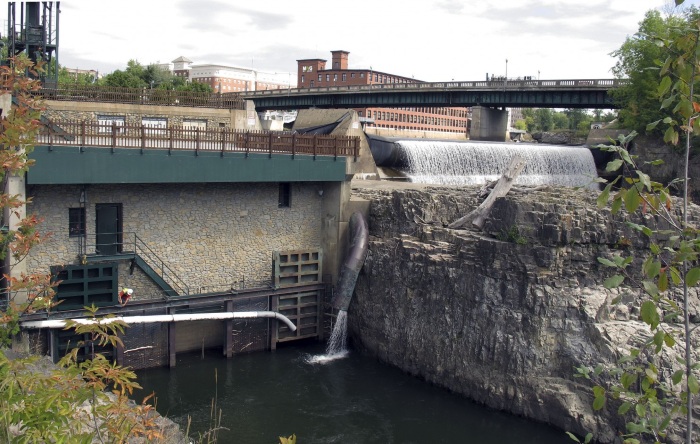With little hoopla surrounding the achievement, Burlington, Vermont added a major socially conscious triumph to its city’s history: 100% of its electricity now comes from renewable sources like wind, water, and biomass.

The city crossed the threshold this month when it purchased the 7.4-megawatt Winooski 1 hydroelectric project on the Winooski River at the city’s edge (pictured above). Once pen left the paper and the ink had dried, Burlington joined the Washington Electric Co-operative (approximately 11,000 customers across central and northern VT) in reaching the 100% mark.
“It shows that we’re able to do it, and we’re able to do it cost effectively in a way that makes Vermonters really positioned well for the future,” said Christopher Recchia, the commissioner of the Vermont Department of Public Service.
Burlington’s initiative is actually part of a broader statewide movement which includes the goal of getting 90% of Vermont’s energy from renewable resources by 2050. All across the state, residents are now requesting electric utilities to provide them with renewable sources of power over traditional.
The good news: the utilities are listening.
Vermont is part of a larger movement being seen across the country right now, as many governments and businesses are looking for ways to free themselves from using power produced by fossil fuels.
Diane Moss, the founding direction of the Renewables 100 Policy Institute, said that she wasn’t sure if any other towns or cities as large as Burlington (pop. 42,000) have reached 100%, but that many are working on it.
“It’s these front-runners that are showing that it’s possible,” she said.
Both large and small businesses, as well as smaller communities have achieved the 100% mark as well. A good example is Greensburg, Kansas, which was nearly destroyed by a 2007 tornado. When the community rebuilt the town, they did so with energy efficiency in mind. A 12.5-megawatt wind farm went online in 2009 and immediately began producing electricity in excess of the town’s 850 residents.
“We’re trying to be as sustainable a community as we can be,” said Greensburg Administrator Ed Truelove.
For Burlington and Washington Electric, weaning the communities off traditional power sources in favor of renewables was a bit more of an arduous task. Utility officials actually began discussing the idea of becoming 100% renewable ten years ago. After four years of looking into it and planning it out, they realized it could be done.
“The transition in thought from 2004 to 2008 was ‘We want to do this’ to ‘This actually makes economic sense for us to do this,’” said Ken Nolan, the manager of power resources for Burlington Electric.
Worth noting is that neither utility will lay claim to the statement that each and every one of their customers’ lights comes from renewable sources ALL the time. When the wind isn’t blowing and the rivers are low, they admitted that they will actually buy power from traditional sources, including fossil fuels. But when resources are right, they are able to get more power than they can use, and the difference is then sold to other utilities. Over time, they sell more than they buy, which allows them to claim on paper the 100% mark.
Patty Richards, general manager of Washington Electric, explains that her company sells high-value “power” credits and then buys less expensive credits back when the sources aren’t there. She says this system helps keep rates low, and ensures their power is 100% renewable.
“It’s like if you get a big old car you’re never going to use, you let somebody rent your car, then you rent back a little smart car or a scooter or something because you don’t have the need,” Richards said.
Taylor Ricketts, director of the Gund Institute for Ecological Economics, an interdisciplinary research center that works on sustainability issues at the University of Vermont, said reaching 100% was a big achievement.
“It definitely makes me feel better here at UVM to know that every time I turn on a light switch or fire up my computer or anything else, to know that it’s 100 percent renewable,” he said.
Story via washingtonpost.com
Advertisement
Learn more about Electronic Products Magazine





